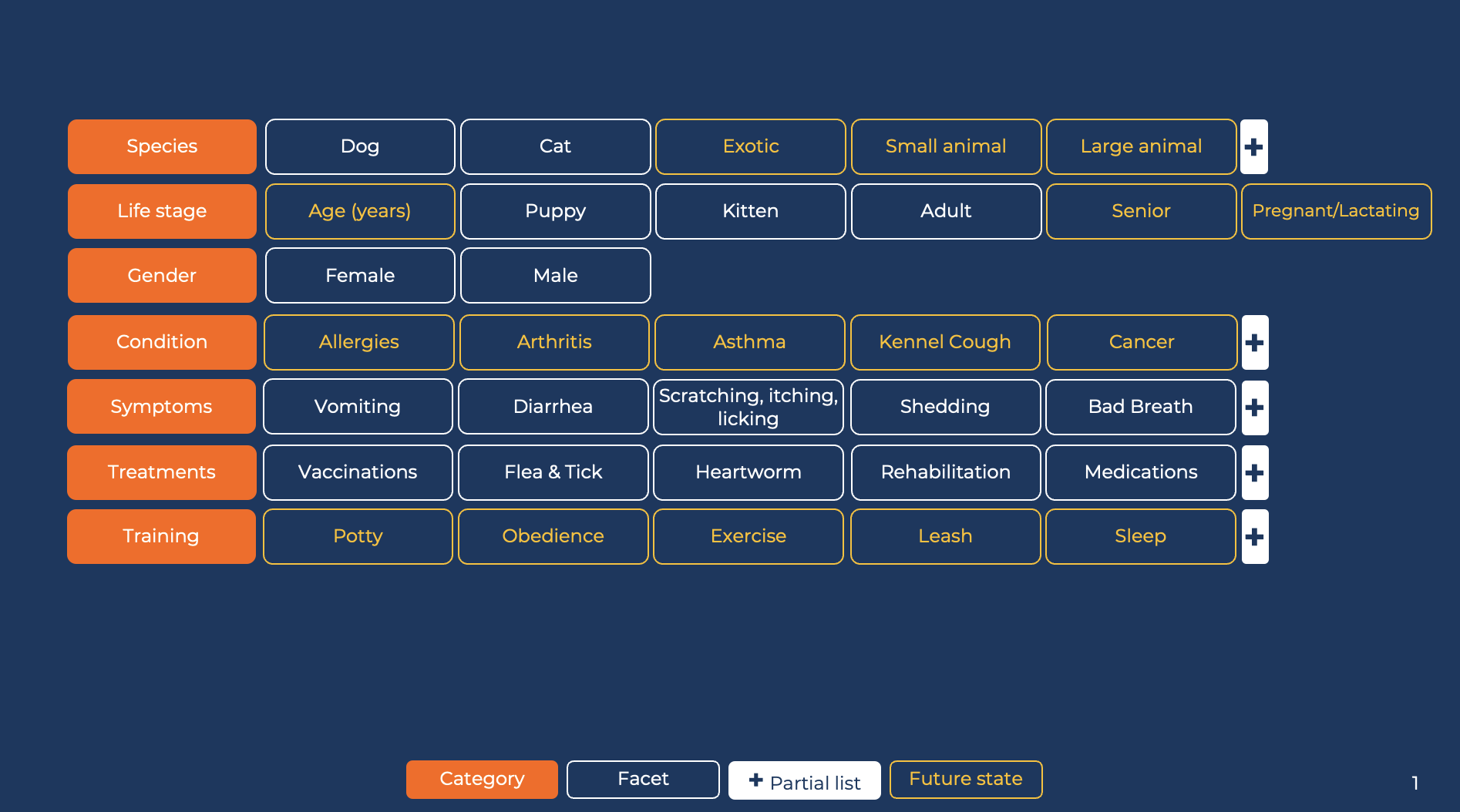Content taxonomy is an essential tool for marketers, one that enables the planning and execution of everything from content strategy and SEO to marketing automation and personalization. As a classification system, it organizes a brand’s content into categories that align with important attributes like product catalogs, audience segments, customer journey phases, formats, and subject matter. It helps marketers understand what content they have (and don’t have), as well as where and how it can be used. Just like the Rosetta Stone helped scholars decipher Egyptian hieroglyphs by translating them into Greek (a language they understood), a content taxonomy helps marketing automation tools like Salesforce Marketing Cloud Personalization, Adobe, or Sitecore CMS recognize what content is right for individual consumers by matching audience data signals to available assets via the shared language of meta data. Here’s an example of what a content taxonomy for a pet care brand might look like:
Why is it important to have a content taxonomy in place?
There are several ways in which a content taxonomy can drive value:
- Better communication across teams: Having a taxonomy in place gets people and systems on the same page. Teams can use the same vernacular to communicate clearly and precisely. It also provides the framework for content organization and management. The taxonomy can be used in folder naming conventions and tagging of assets in your Digital Asset Management (DAM) and Customer Management System (CMS). This makes it easier for team members and search bots to recognize and find assets.
- More informed decision making and content strategy: The process of creating a taxonomy requires auditing current content, documenting audience needs, and mapping relevance to the context of customer journeys and channels. It serves as a forcing function to fill in knowledge gaps that helps teams uncover opportunities and guide content strategy.
- Improved SEO performance and personalization: Marketing automation is enabled by the application of taxonomy. Personalization requires the use of meta data to match content assets to data signals, rules and algorithms that decide what content to show to which consumer. A strong taxonomy will support more sophisticated automation and optimization over time. It will also aid SEO performance by helping the team identify, develop, and associate content with high-value topics and keywords.
Without a taxonomy, the opposite is often true. Miscommunication can occur across the organization as individual work groups develop their own descriptions for customer segments, journey moments, and interests. Meanwhile, content strategy and available assets may focus disproportionately on one type of customer or marketing objective to the detriment of the holistic experience—leading to underperformance in attracting organic traffic, engagement, or retention.
What should you do to improve your content taxonomy?
Ask yourself these questions to help focus your efforts:
- “Should we develop one?” If you’re asking this question, you probably don’t have a robust content taxonomy already in place. Think about how you can use it. Think about who inside and outside your organization can help you conduct the research and collaboration needed to build it out. Get these people in a room and discuss the merits of such an endeavor and the roadmap for getting started. Even a lightweight first version can help the team think strategically and communicate better.
- “Is our existing taxonomy lacking depth in key areas?” Maybe you have a deep product catalog with categories, sub-categories, attributes, and SKUs, but you don’t have a detailed breakout of customer personas, interests or journey moments. You may have a blind spot in understanding customer mindsets and needs. Consider primary and secondary research to fill in these gaps. Insights into motivations, needs, and barriers throughout the customer journey will allow you to build out a deep taxonomy for all phases and channels.
- “Do we have a content strategy in place that addresses prioritized gaps in answering customer needs?” Your reporting around SEO, site analytics, and conversion funnels likely point to blockers and barriers where your customers are not engaging or moving forward in the journey. Some of these can be addressed with new content deployed in the right channels. Prioritize key moments and conversion points where new and enhanced content can make the difference. Then use your taxonomy to identify the topics and types of content that you should create.
- “Are we able to personalize customer experiences by surfacing the right asset at the right time?” Achieving maturity in personalization takes time. Maybe you need more versioned content to speak to specific audience segments. Maybe you need to capture additional data signals and train automation rules to match them to specific assets and offers. Use your taxonomy to identify the missing pieces. There may be some categories where you lack content and others where you are unable to recognize audience members.
The Takeaway
Depending on how you answered these questions, it may be time to organize a content taxonomy task force and start the process of getting to v1. Or you may want to dive into customer interviews and keyword research to add detail to your taxonomy for key moments and phases of the customer journey. Either way, thinking about the state of your content taxonomy should shed light on your marketing maturity level and help identify opportunity areas to consider for your next planning session.



